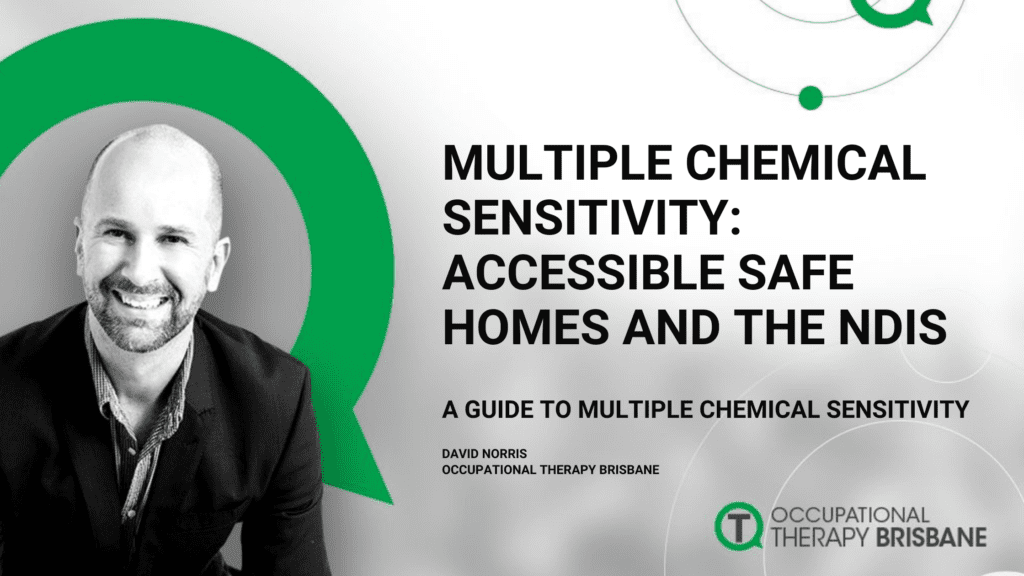
Every time a worker comes into her home with well applied eucalyptus scented hand sanitizer, Mary* is terrified for her life.
On the days where there is a mild fragrance scent trail, she’s well aware she’ll have a mood, memory and functional crash. This means even walking to the bathroom will be beyond her. What’s more, these crashes can last days to weeks.
In our NDIS and Home Modifications program we’ve come to observe such is life when living with Multiple Chemical Sensitivity and are determined to help people overcome this complex and challenging situation.
You see, even the mildest of exposures to chemicals in
- food ingredients, building materials, fragrances, cleaning products, car exhaust, laundry products, household furniture and cigarette smoke for example can trigger a person’s mind and body into a functional fall out.
This can have profound impact on a person’s life.
When living with this chemical sensitivity syndrome, the world is more toxic and it’s becoming clear what is needed to get ahead of this devastating condition.

Free Chemical Sensitivity Checklist
Free Chemical Sensitivity Checklist

Free Chemical Sensitivity Checklist


This was much like a sign on the community board at the local Coles.
In this guide to multiple chemical sensitivity you’ll learn
- What Is Multiple Chemical Sensitivity
- Why Is It A Contentious Issue and What Is The Current Medical View, including,
- What Is The Diagnostic Criteria for MCS
- What Are The Symptoms Of Multiple Chemical Sensitivity
- What Are Other Health Problems Commonly Observed In People Living With MCS
- The 7 Conditions Linked To Chemical Exposures
- How Does A Person Become Sensitive To Multiple Chemicals?
- Is Multiple Chemical Sensitivity A Disability?
- National Disability Insurance Scheme For People Living With MCS
- Housing Access and Risk of Homelessness
- How Do You Treat Multiple Chemical Sensitivity? Clues To Better Home Design
- How Occupational Therapy Can Help When Living With Multiple Chemical Sensitivity
LIVING WITH MULTIPLE CHEMICAL SENSITIVITY? IS YOUR HOME SAFE?
We’ve been exposed to unprecedented levels of chemicals since World War II, especially indoors, where we spend most of our time. Adverse responses to chemicals was first documented by Dr. Theron Rudolph in 1961 who coined the term “environmental illness”.
No doubt we’re super focused on how we can help maximise a person’s independence at home but what can we do about the chemical environment which can significantly impact your
- Balance
- Thinking and Memory Skills
- Endurance to walk or like the above, sustain concentration

WHAT IS MULTIPLE CHEMICAL SENSITIVITIES
Often reported in medical literature as “idiopathic” meaning, being of unknown origin. Yet if you’re to ask an individual about their experience they’d commonly site a specific triggering event.
A person living with multiple chemical sensitivity (MCS) are often sensitive to many chemicals and may experience symptoms in more than one body system or mutlisystem symptoms.
Multiple Chemical Sensitivity has also been linked with a viral infection or other illnesses and can be observed with hormonal changes, e.g. such as before, during and after pregnancy.
No doubt it’s a complex picture and the search for understanding the mechanistic causes can undermine the need to respond to the symptoms that people experience which threaten their quality of life, their ability to go to work, drive a car or live an ordinary life.
A Contentious Issues: Multiple Food and Chemical Sensitivities: Idiopathic Environmental Intolerance
In 1996, an expert panel of the World Health Organization/International Classification for Patient Safety (WHO/ICPS) accepted the existence of MCS as a health condition with a cause unknown, and suggested that it be called “idiopathic environmental intolerances”(IEI). So where does that leave us? The term MCS is still widely used but the definition is becoming clearer; an acquired disorder with multiple recurrent symptoms associated with environmental chemicals in low concentrations that are well tolerated by the majority of people. In summary, there a person appears to have chemical intolerancesCurrent Diagnostic Criteria For MCS
In 2005 Lacour and colleagues established the following criteria which is also later supported by the Italian Working Group of Damiani and associates in 2021.
- symptom duration of at least 6 months
- symptoms in response to at least 2 of 11 categories of chemical exposures
- at least one central nervous system symptom is present (eg fatigue, headaches or neurocognitive deficits, and one symptom from another organ system
- symptoms causing adjustments of personal lifestyle, or of social or occupational life
- symptoms occurring when exposed and improving or resolving when exposures are removed
- symptoms are triggered by exposure levels that do not induce symptoms in other individuals who are exposed to the same levels

WHAT ARE THE SYMPTOMS OF MULTIPLE CHEMICAL SENSITIVITY
Individuals diagnosed with MCS do not exhibit a specific symptom pattern. A wide range of individual symptoms have been described with the most prominent symptoms being:
- Cardiological (heart) tachycardia
- Respiratory (nasal congestions, sore throat, and breathing difficulties),
- Constitutional (fatigue, headache, joint aches, back pain, muscle aches, and weakness),
- Neuropsychologic ( Brain dysfunction such as memory loss, forgetfulness, and mood or personality changes, brain fog).
- Mental health
- Cutaneous (skin), allergic,
- Gastrointestinal (pain, bloating, nausea, changes in bowel routines)
- Endocrinological (hormonal) symptoms
This multisystem diversity makes it so challenging if you’re suffering from MCS as it feels like you’re jumping at the symptoms and not seeing the connection.
So, the likely question is what other health conditions are associated with MCS?
What Other Health Problems Do People Living With MCS Have?
Prior studies as well as assessment tools use symptoms clusters, but very few studies have investigated comorbid disease clusters.
Palmer and colleagues in 2021 studied 200 people who were diagnosed with and without chemical sensitivities. Those with highest MCS symptom scores had a greater chance of being diagnosed with
- Irritable Bowel Syndrome, Arthritis, Depression, Anxiety, Fibromyalgia, and Myalgic encephalomyelitis/chronic fatigue syndrome (ME/CFS)
Miller and colleagues also extends this observation proposing that there are other conditions which may have their origins in MCS notably
- ADHD, Tinnitus, Gulf War Syndrome, Arrhythmias, changes in blood pressure such as Hypertension and Hypotension and Asthma

THE 7 CONDITIONS LINKED TO CHEMICAL EXPOSURES
For people suffering with conditions listed in the 7 A’s, understanding the MCS process can help identify low‐risk interventions that can improve quality of life for patients and their families, according to Dr Miller. This list is thought to be due to the gene- environment interaction and according to Dr Miller of UT Health, are increasingly common diagnoses which may be initiated or exacerbated by food and chemical exposures
- Autism
- ADHD
- Asthma
- Allergies
- Addiction
- Affective Mood Disorders: Depression, Bipolar disorder, Anxiety Disorder
- Autoimmune Disease

Free Chemical Sensitivity Checklist
Free Chemical Sensitivity Checklist

Free Chemical Sensitivity Checklist

HOW MANY AUSTRALIANS ARE EXPECTED TO LIVE WITH MULTIPLE CHEMICAL SENSITIVITY?
A 2018 study randomly selected 1098 Australian’s across the community and found MCS is widespread in the Australian population. From the data it’s expected to affect more than one million adults.
The study led by Prof. Steinman in 2018 reported that across Australia
- 6.5% report medically diagnosed MCS,
- 18.9% report chemical sensitivity (being unusually sensitive to everyday chemicals and chemically formulated products),
This aligns with the global observations where MCS has an estimated prevalence of upto 6.5% in medically evaluated patients and a self-reported prevalence around 11% in the general population (Damiani et al, 2021).
HOW DOES A PERSON BECOME SENSITIVE TO MULTIPLE CHEMICALS?
According to Dr Miller of UT Health in San Antonio she describes a two stage process
Stage 1.
A person develops multiple system symptoms and intolerances for ordinary substances that never bothered him before and don’t bother most people.
Stage 2
When you’re exposed to even small amounts of unrelated compounds, foods, and drugs, can trigger a broad range of reactions which vary depending on the dose.
In Dr Miller’s perspective there is a loss of tolerance to toxicants in the environment, and like bamboo buffeted by strong and persistent breeze, the body systems no longer a flexible and resilient.
The Ongoing Risk Of Chemical Exposures To A Person With Multiple Chemical Sensitivity
The risk of sustained exposure to chemicals includes a range of acute, chronic, and potentially disabling health effects, such as headaches, dizziness, seizures, heart arrhythmia, gastrointestinal problems, breathing difficulties, and asthma attacks.
MCS ranges in seriousness from mild to severe and there is no known cure.

IS MULTIPLE CHEMICAL SENSITIVITY A DISABILITY?
“A growing number of people report being affected by sensitivity to chemicals used in the building, maintenance and operation of premises,” according to the Australian Human Rights and Equal Opportunity Commission. “This can mean that premises are effectively inaccessible to people with chemical sensitivity.”
In Prof Steinman’s Australian study of people living with MCS she reported
- 77.5% are prevented from access to places because of fragranced products, 52.1% lost workdays or a job in the past year due to fragranced product exposure in the workplace, and 55.4% report health effects considered potentially disabling.
National Disability Insurance Scheme For People Living With MCS
The Australian Disability Strategy 2021 – 2031 commits to “increasing the number of accessible, affordable and well-designed homes and creating a community that is inclusive and accessible” and builds on the former action agenda of “fully inclusive Australian society that enables people with disability to fulfil their potential as equal members of the community”
Accessible Homes: SDA For People Living With Multiple Chemical Sensitivities
For participants living with Multiple Chemical Sensitivities (M.C.S) the human rights embedded in the NDIS strategy aren’t presently available to them in the SDA marketplace.
Though there is a need an opportunity. We’ve noted an increase in NDIS Occupational Therapy Assessment referrals for people demonstrating or diagnosed with this chemical sensitivity syndrome.
The issue is the consistent lack of adequate disability support. This has been well documented for those with Multiple Chemical Sensitivity (MCS) in the areas of
- Access to NDIS and access to disability supports and services
- Affordable and safe housing for those with MCS (Martin, 2020)
- Lack of suitable SDA housing for people living with MCS “Inclusive and Accessible homes for all : Emerging SDA opportunities for people living with multiple chemical sensitivities” (by our very own David Norris, 2022)

HOUSING ACCESS AND RISK OF HOMELESSNESS
People with MCS often experience difficulties finding housing that is appropriate and accessible for their condition. As a result, homelessness is persistent risk for people with MCS.
A 2019 study of people living with MCS further found that 55.2% of respondents reported suffering hardship accessing safe and affordable housing.
Furthermore a U.S housing survey of people living with MCS reported
- 57% of respondents had experienced homelessness during their illness (compared to 1% of the general population reporting having experienced homeless in their lifetime)
- 25% had lived in a car (nine months average)
- 15% had lived in a tent (eight months average)
- 73% of respondents had lived in a house that made them sick

HOW DO YOU TREAT MULTIPLE CHEMICAL SENSITIVITY? CLUES TO BETTER HOME DESIGN
There is no clinically backed treatment intervention to cure MCS.
What is consistent across the literature is that there is a need to remove the triggers. In short to avoid those substances related to a person’s experience of MCS.
For the person living with advanced MCS, the need to go to hospital is a terrifying and possibly life threatening event. The emergence of the Environmental Medical Unit allows a safe environment for a person to reduce and stabilise their symptoms. The unit also allows the reintroduction of materials and foods in order to identify and map a person’s triggers.
Specifically the unit includes:
- Filtered air supply and continuous air monitoring to ensure the removal of Volatile Organic Compounds (VOCs) and fine particulates (e.g., charcoal filters plus HEPA filters)
- Positive pressure, relative to surrounding home areas
- Filtered water
- Access to foods with low chemical loads
- Non-outgassing furnishings and construction materials (no chemicals being released to the air)
- Safest possible cleaning and operational practises
- Low Electromagnetic Fields
- Sound dampened room environments using combination of wall, window, ceiling and furniture materials and items
A survey of 1000 people’s experience of managing MCS found 9 out of 10 respondents reported creating a chemical-free living environment and avoiding chemicals was the best strategy they had applied in their lives.
For some like Mary* her home can be haven or dungeon where continued exposures to triggering chemicals continues to compound more and more health issues and a life collapse where she is reliant on other people.
There is clearly a multidisciplinary need for health professions, designers, valuers, engineers, NDIS and Insurers as well as the wider construction industry to attend to the environmental needs of people living with MCS .

HOW OCCUPATIONAL THERAPY CAN HELP WHEN LIVING WITH MULTIPLE CHEMICAL SENSITIVITY
At Occupational Therapy Brisbane we’re committed to assisting people access the right home so that they can achieve the vision at the heart of the word “home”
Home has origins in old Germanic and means ” A place from which the world can be founded”
This is no doubt under threat when living with MCS.
If you’re looking for and NDIS assessment to map out the impact of MCS, to offer home modification advice or workforce capability recommendations then please call us at 1300 783 200

Free Chemical Sensitivity Checklist
Free Chemical Sensitivity Checklist

Free Chemical Sensitivity Checklist












